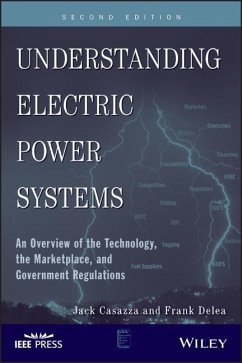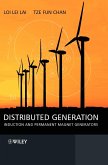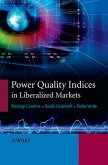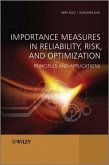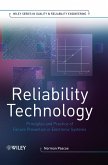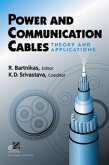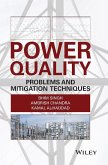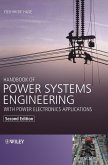Frank Delea, Jack Casazza
Understanding Electric Power Systems
An Overview of the Technology, the Marketplace, and Government Regulations
Frank Delea, Jack Casazza
Understanding Electric Power Systems
An Overview of the Technology, the Marketplace, and Government Regulations
- Broschiertes Buch
- Merkliste
- Auf die Merkliste
- Bewerten Bewerten
- Teilen
- Produkt teilen
- Produkterinnerung
- Produkterinnerung
Technological advances and changes in government policy and regulation have altered the electric power industry in recent years and will continue to impact it for quite some time. Fully updated with the latest changes to regulation, structure, and technology, this new edition of Understanding Electric Power Systems offers a real-world view of the industry, explaining how it operates, how it is structured, and how electricity is regulated and priced. It includes extensive references for the reader and will be especially useful to lawyers, government officials, regulators, engineers, and…mehr
Andere Kunden interessierten sich auch für
![Distributed Generation Distributed Generation]() Loi Lei LaiDistributed Generation147,99 €
Loi Lei LaiDistributed Generation147,99 €![Power Quality Indices in Liberalized Markets Power Quality Indices in Liberalized Markets]() Pierluigi CaramiaPower Quality Indices in Liberalized Markets136,99 €
Pierluigi CaramiaPower Quality Indices in Liberalized Markets136,99 €![Importance Measures in Reliability, Risk, and Optimization Importance Measures in Reliability, Risk, and Optimization]() Way KuoImportance Measures in Reliability, Risk, and Optimization146,99 €
Way KuoImportance Measures in Reliability, Risk, and Optimization146,99 €![Reliability Technology Reliability Technology]() Norman PascoeReliability Technology126,99 €
Norman PascoeReliability Technology126,99 €![Power and Communication Cables Power and Communication Cables]() Ray BartnikasPower and Communication Cables258,99 €
Ray BartnikasPower and Communication Cables258,99 €![Power Quality Power Quality]() Bhim SinghPower Quality164,99 €
Bhim SinghPower Quality164,99 €![Handbook of Power Systems Engineering with Power Electronics Applications Handbook of Power Systems Engineering with Power Electronics Applications]() Yoshihide HaseHandbook of Power Systems Engineering with Power Electronics Applications201,99 €
Yoshihide HaseHandbook of Power Systems Engineering with Power Electronics Applications201,99 €-
-
-
Technological advances and changes in government policy and regulation have altered the electric power industry in recent years and will continue to impact it for quite some time. Fully updated with the latest changes to regulation, structure, and technology, this new edition of Understanding Electric Power Systems offers a real-world view of the industry, explaining how it operates, how it is structured, and how electricity is regulated and priced. It includes extensive references for the reader and will be especially useful to lawyers, government officials, regulators, engineers, and students, as well as the general public. The book explains the physical functioning of electric power systems, the electric power business in today's environment, and the related institutions, including recent changes in the roles of the Federal Energy Regulatory Commission and the North American Reliability Company. Significant changes that are affecting the industry are covered in this new edition, including:
The expanded role of the federal government in the planning and operation of the nation's electric utilities
New energy laws and a large number of FERC regulations implementing these laws
Concerns over global warming and potential impacts on the electric industry
Pressures for expansion of the electric grid and the implementation of "smart-grid" technologies
The growing importance of various energy-storage technologies and renewable energy sources
New nuclear generation technologies
The 2009 economic stimulus package
Hinweis: Dieser Artikel kann nur an eine deutsche Lieferadresse ausgeliefert werden.
The expanded role of the federal government in the planning and operation of the nation's electric utilities
New energy laws and a large number of FERC regulations implementing these laws
Concerns over global warming and potential impacts on the electric industry
Pressures for expansion of the electric grid and the implementation of "smart-grid" technologies
The growing importance of various energy-storage technologies and renewable energy sources
New nuclear generation technologies
The 2009 economic stimulus package
Hinweis: Dieser Artikel kann nur an eine deutsche Lieferadresse ausgeliefert werden.
Produktdetails
- Produktdetails
- IEEE Press Understanding Science & Technology Series
- Verlag: Wiley & Sons
- 2. Aufl.
- Seitenzahl: 352
- Erscheinungstermin: 1. März 2010
- Englisch
- Abmessung: 238mm x 159mm x 24mm
- Gewicht: 483g
- ISBN-13: 9780470484180
- ISBN-10: 0470484187
- Artikelnr.: 27523799
- Herstellerkennzeichnung
- Libri GmbH
- Europaallee 1
- 36244 Bad Hersfeld
- gpsr@libri.de
- IEEE Press Understanding Science & Technology Series
- Verlag: Wiley & Sons
- 2. Aufl.
- Seitenzahl: 352
- Erscheinungstermin: 1. März 2010
- Englisch
- Abmessung: 238mm x 159mm x 24mm
- Gewicht: 483g
- ISBN-13: 9780470484180
- ISBN-10: 0470484187
- Artikelnr.: 27523799
- Herstellerkennzeichnung
- Libri GmbH
- Europaallee 1
- 36244 Bad Hersfeld
- gpsr@libri.de
JACK CASAZZA is an electrical engineer with wide experience in the electric power profession as an executive, researcher, economist, and consultant. He has served as vice president in a major utility responsible for elec- tric and gas planning and research, as a member of the Board of Directors of the Georgia System Operating Co., and as chairman of the U.S. Technical Committee of CIGRE. Casazza is the author of six books on electric power policy and technology and founded the American Education Institute. An IEEE Life Fellow, he received the Halperin Award for his contributions to the development of the national transmission system. FRANK DELEA is retired from Consolidated Edison Company, where he had a wide range of assignments giving him insight into planning, operational, financial, organizational, and legal issues. He was the company's chief electric planning engineer, its chief forecast engineer, its first project manager for rate cases, and a corporate planning director. He is an IEEE Senior Member. Since his retirement, Delea has conducted many short courses in technical, business, and regulatory issues relating to electric power systems for non-engineers.
Preface to the Second Edition xv
Acknowledgments xix
Chapter 1 Benefits of Electric Power and a History of the Electric Power
Industry 1
1.1 Societal Benefits of Electricity 1
1.2 Origin of the Industry 2
1.3 The Development of the National Electric Power Grid 5
1.4 "The Golden Age" 8
Blackouts and the Reliability Crisis 9
The Environmental Crises-The Shift to Low-Sulfur Oil 10
The Fuel Crisis-The Shift from Oil 10
The Financial Crisis 11
The Legislative and Regulatory Crisis 12
1.5 Global Warming Crisis and Concerns about Carbon Emissions 13
1.6 Restructuring, Competition, and the Industry 13
Ownership Structure
Chapter 2 The Electric Power System 15
2.1 The Customers 16
2.2 Sources of the Electric Energy-Generation 17
2.3 The Delivery System 20
Interconnections 24
The Grid 24
Chapter 3 Basic Electric Power Concepts 27
3.1 Electric Energy 28
3.2 Concepts Relating to the Flow of Electricity 30
Direct Current (DC) 31
Alternating Current (AC) 31
Three Phases 33
Synchronism 34
3.3 Characteristics of AC Systems 34
Resistance 34
Induction and Inductive Reactance 35
Capacitance and Capacitive Reactance 36
Impedance 38
3.4 Ohm's Law for Alternating Current 38
3.5 Power in Alternating Current Circuits 39
Real Power 40
Reactive Power 40
Transformers 42
3.6 Power Flow 43
Division of Power Flow 43
Voltage Drop and Reactive Power Flow 44
3.7 Stability 44
Automatic Generation Controls (AGC) 46
Results of Instability 47
Chapter 4 Electric Energy Consumption 49
4.1 End Uses for Electricity 49
4.2 Customer Classes 50
4.3 Rate Classes 51
4.4 Demand and Energy 51
Energy 52
Effects of Load Diversity 53
4.5 System Load 55
Load Management 57
4.6 Reactive Load 59
4.7 Losses and Unaccounted-For Energy in the Delivery System 59
4.8 Forecasts 61
Chapter 5 Electric Power Generation and Concerns About Greenhouse Gases 65
5.1 Generation's Role 65
5.2 Types of Generation 66
5.3 Thermal Conversion: Using Fuel as the Energy Resource 69
Steam Cycle-Steam Turbines 69
Combustion (Gas) Turbines 70
Combined Cycle 71
Nuclear 72
Reciprocating Engines 73
Microturbines 74
Combined Heat and Power (CHP) or Cogeneration 74
5.4 Thermal Conversion: Nonfuel Heat Sources 74
Geothermal 74
Solar Thermal Generation 75
5.5 Mechanical Energy Conversion 75
Hydroturbines and Hydropumped Storage 75
Wind Turbines 77
Distributed Generation and Other Sources 78
5.6 Renewable Technologies and Greenhouse Gas Emissions 79
Supply-Side Options to Reduce Greenhouse Gas Emissions 79
Financial Options to Reduce Carbon Emissions 83
5.7 Characteristics of Generating Plants 84
Size 85
Efficiency 87
Availability 88
Schedulable and Unschedulable Units 90
5.8 Capital Cost of Generation 90
5.9 Generator Life Extension 91
5.10 The Technology of Generation 91
Synchronous Generators 91
Variable Frequency and Direct Current Generation 92
5.11 System Needs and Evaluation of Intermittent Resources 93
Chapter 6 The Technology of the Electric Transmission System 97
6.1 Components 97
6.2 HVAC 98
Overhead Lines 98
Overhead Line Capability-Ratings 99
Transmission Cable 101
Cable Capacity 101
Submarine Cables 102
Superconducting Cables 102
6.3 Substations 102
Substation Equipment 103
Substation Circuit Breaker Arrangements 108
Transmission System Aging 108
6.4 HVDC 108
6.5 Advantages of AC over DC Operation 110
Advantages of HVDC 111
Disadvantages of HVDC 112
6.5 Knowledge Required of Transmission Systems 113
Chapter 7 Distribution 115
7.1 Function of Distribution 115
7.2 Primary Distribution Feeders 116
Radial Systems 116
Loop Systems 117
Primary Network Systems 117
Secondary Systems 117
7.3 Distribution Capacity 118
7.4 Losses 119
7.5 Distribution Facility Ratings 119
7.6 Metering 120
7.7 Control of Distribution Voltages 120
Distribution Transformers 121
Voltage Regulators 122
Capacitors 123
7.8 Distribution System Reliability 123
7.10 Quality of Service 124
7.11 Design of Distribution Systems 125
7.12 Distributed Generation 125
7.13 Operation of Distribution Systems 126
7.14 Smart Grids and Microgrids 127
Chapter 8 Energy Storage and Other New Technologies 129
8.1 Energy Storage 131
Benefits of Energy Storage to Generation 131
Benefits of Energy Storage to Transmission and Distribution 132
8.2 Energy Storage Concepts and Technologies 133
Mechanical Systems 133
Thermal Energy Storage 136
Chemical Energy Storage 138
Batteries 138
Hydrogen Energy Storage Systems 139
Electrical Storage 140
Superconducting Magnetic Energy Storage 141
Power Conversion Equipment 141
The Future for Energy Storage 142
8.3 Smart Grid 142
Microgrids 146
8.4 New Nuclear Plant Designs 146
8.5 Carbon Sequestration and Clean Coal Technologies 150
8.6 Superconductors 153
Chapter 9 Reliability 155
9.1 Causes of Outages 155
9.2 Costs of Power Outages 157
9.3 Ways to Measure Reliability 158
9.4 Planning and Operating a Reliable and Adequate 159
Power System
Generation 164
Transmission 165
Distribution 166
9.5 Summary 166
Chapter 10 The Physical Network: The North American Electric Reliability
Corporation (NERC) and Its Standards 167
10.1 NERC as Electric Reliability Organization 169
10.2 NERC Standards 171
Functional Model 171
10.3 Development of Standards 176
Reliability Principles 177
Market Interface Principles 177
Compliance with NERC Standards 179
Other NERC Responsibilities 179
The Future 180
Chapter 11 The Physical Network: Operation of the Electric Bulk Power 181
11.1 Balancing Authorities 181
Area Control 182
Operating Reserves 184
11.2 Reliability Coordinators 184
11.3 Transmission Operators 186
Power Transfer Limits 186
Determination of Total Transfer Capability 187
Parallel Path Flow and Loop Flow 188
Reduction of Power Transfers-Congestion Management 189
Ancillary Services 189
11.4 Voltage and Reactive Control 191
11.5 Emergencies 192
Operating Emergencies 193
11.6 Information Exchange 194
Chapter 12 The Physical Network: Planning of the Electric Bulk Power System
197
12.1 Planning Standards 198
12.2 Generation Planning 198
12.3 Transmission Planning 200
Transmission System Planning Studies 203
12.4 Least Cost Planning 205
12.5 The New Planning Environment 205
Recent Transmission Projects 211
Chapter 13 The Regulatory Network: Legislation 213
13.1 Pricing and Regulation 213
13.2 Federal Legislation 214
13.3 Federal Utility Holding Company Act (PUHCA) 214
13.4 Federal Power Act 216
13.5 Other 1930 Federal Laws 219
13.6 Department of Energy Organization Act 219
13.7 Public Utility Regulatory Policies Act (PURPA) 220
13.8 Energy Policy Act of 1992 (EPAct02) 222
13.9 The Energy Policy Act of 2005 (EPAct05) 224
13.10 The Energy Independence and Security Act of 2007 227
13.11 Environmental Laws 227
13.12 2009 American Recovery and Reinvestment Act 230
Chapter 14 The Regulatory Network: The Regulators 231
14.1 The Regulators 231
Federal Energy Regulatory Commission (FERC) 231
Environmental Protection Agency (EPA) 233
Department of Energy (DOE) 234
Nuclear Regulatory Commission (NRC) 236
Recent Federal Regulations 237
FERC Actions after EPAct92 237
FERC Actions Implementing EPAct05 242
Market Manipulation 242
Electricity Reliability and Infrastructure 242
Expansion and Modernization of the Nation's Electricity Grid 245
Siting Major New Transmission Facilities 245
PURPA Reforms 246
Repeal of PUHCA-Mergers and Acquisitions 246
Market-Based Rates 247
Recent EPA Actions 248
State Regulatory Authority 249
State Utility Restructuring 250
Overall Regulatory Problems 251
Chapter 15 The Information, Communication, and Control Network and Security
253
15.1 Smart Grid 253
15.2 Financial and Business Operations 254
15.3 System Operations 255
15.4 Distribution Operations 255
15.5 Cyber Security 256
15.6 Nuclear Plant Security 259
Chapter 16 The Fuel and Energy Network 261
16.1 Resource Procurement 264
Fuel Measurements 265
16.2 Fuel Transportation 265
16.3 Fuel Diversity 266
16.4 Fossil Fuels Used 267
16.5 Renewable Energy 269
16.6 Fuel Purchasing 271
16.7 Emission Rights 271
Chapter 17 The Business Network: Market Participants 273
17.1 Investment and Cost Recovery 273
17.2 The Changing Industry Structure 274
Functional Unbundling 274
Additional Utility Responses 275
ISO/RTO Formation 275
Holding Company Formation 275
Power Plant Divestitures 277
17.3 New Structures 279
Power Producers 279
Independent Transmission Companies and Operators 279
Impact of Restructuring on the Transmission System 280
Distributors 280
Power Marketers 281
17.4 New Corporate Ownership 281
Utility Mergers and Acquisitions 282
Acquisitions by Foreign Companies 282
Financial Institutions 283
Chapter 18 The Money Network: Wholesale Markets 285
18.1 The Energy Markets 286
Standard Market Design (SMD) 288
Locational Marginal Pricing (LMP) 289
18.2 Transmission 291
Transmission Rights 291
Physical Transmission Rights (PTRs) 292
Financial Transmission Rights (FTRs) 293
Wheeling and Customer Choice 294
Contracts and Agreements 294
Average System versus Incremental Costs 295
18.3 Customer Late Issues 294
Construction Work in Progress (CWIP) 295
Setting of Rates 296
Rate Freezes 296
Allocation of Costs and Economic Benefits 296
Average Costs versus Incremental Costs 297
18.4 Market versus Operational Control 298
18.5 Market Power Issues 298
Price Caps 299
18.6 The Future 299
Chapter 19 The Professional and Industry Organizations 301
19.1 The Professional Organizations 301
The Institute of Electrical and Electronics Engineers (IEEE) 301
The American Society of Civil Engineers (ASCE) 303
American Society of Mechanical Engineers 304
(ASME) and the American Institute of Chemical Engineers (AIChE) CIGRE 304
19.2 Industry Associations 304
NEMA 304
The Association of Edison Illuminating 305
Companies (AEIC)
The American Public Power Association (APPA) 305
The Edison Electric Institute (EEI) 306
The Electricity Consumer Resource Council (ELCON) 306
The National Rural Electric Cooperative Association (NRECA) 307
Electric Power Supply Association (EPSA) 307
The Nuclear Energy Institute (NEI) 308
19.3 Public Interest Groups 308
The National Association of Regulatory Utility 308
Commissioners (NARUC)
Environmental Defense Fund (EDF) 308
Public Citizen 309
Public Interest Law Project 309
19.4 Research Organizations 309
The Electric Power Research Institute (EPRI) 310
Other Research 310
The National Regulatory Research Institute (NRRI) 311
The Power Systems Engineering Research Center (PSERC) 311
Index 313
Acknowledgments xix
Chapter 1 Benefits of Electric Power and a History of the Electric Power
Industry 1
1.1 Societal Benefits of Electricity 1
1.2 Origin of the Industry 2
1.3 The Development of the National Electric Power Grid 5
1.4 "The Golden Age" 8
Blackouts and the Reliability Crisis 9
The Environmental Crises-The Shift to Low-Sulfur Oil 10
The Fuel Crisis-The Shift from Oil 10
The Financial Crisis 11
The Legislative and Regulatory Crisis 12
1.5 Global Warming Crisis and Concerns about Carbon Emissions 13
1.6 Restructuring, Competition, and the Industry 13
Ownership Structure
Chapter 2 The Electric Power System 15
2.1 The Customers 16
2.2 Sources of the Electric Energy-Generation 17
2.3 The Delivery System 20
Interconnections 24
The Grid 24
Chapter 3 Basic Electric Power Concepts 27
3.1 Electric Energy 28
3.2 Concepts Relating to the Flow of Electricity 30
Direct Current (DC) 31
Alternating Current (AC) 31
Three Phases 33
Synchronism 34
3.3 Characteristics of AC Systems 34
Resistance 34
Induction and Inductive Reactance 35
Capacitance and Capacitive Reactance 36
Impedance 38
3.4 Ohm's Law for Alternating Current 38
3.5 Power in Alternating Current Circuits 39
Real Power 40
Reactive Power 40
Transformers 42
3.6 Power Flow 43
Division of Power Flow 43
Voltage Drop and Reactive Power Flow 44
3.7 Stability 44
Automatic Generation Controls (AGC) 46
Results of Instability 47
Chapter 4 Electric Energy Consumption 49
4.1 End Uses for Electricity 49
4.2 Customer Classes 50
4.3 Rate Classes 51
4.4 Demand and Energy 51
Energy 52
Effects of Load Diversity 53
4.5 System Load 55
Load Management 57
4.6 Reactive Load 59
4.7 Losses and Unaccounted-For Energy in the Delivery System 59
4.8 Forecasts 61
Chapter 5 Electric Power Generation and Concerns About Greenhouse Gases 65
5.1 Generation's Role 65
5.2 Types of Generation 66
5.3 Thermal Conversion: Using Fuel as the Energy Resource 69
Steam Cycle-Steam Turbines 69
Combustion (Gas) Turbines 70
Combined Cycle 71
Nuclear 72
Reciprocating Engines 73
Microturbines 74
Combined Heat and Power (CHP) or Cogeneration 74
5.4 Thermal Conversion: Nonfuel Heat Sources 74
Geothermal 74
Solar Thermal Generation 75
5.5 Mechanical Energy Conversion 75
Hydroturbines and Hydropumped Storage 75
Wind Turbines 77
Distributed Generation and Other Sources 78
5.6 Renewable Technologies and Greenhouse Gas Emissions 79
Supply-Side Options to Reduce Greenhouse Gas Emissions 79
Financial Options to Reduce Carbon Emissions 83
5.7 Characteristics of Generating Plants 84
Size 85
Efficiency 87
Availability 88
Schedulable and Unschedulable Units 90
5.8 Capital Cost of Generation 90
5.9 Generator Life Extension 91
5.10 The Technology of Generation 91
Synchronous Generators 91
Variable Frequency and Direct Current Generation 92
5.11 System Needs and Evaluation of Intermittent Resources 93
Chapter 6 The Technology of the Electric Transmission System 97
6.1 Components 97
6.2 HVAC 98
Overhead Lines 98
Overhead Line Capability-Ratings 99
Transmission Cable 101
Cable Capacity 101
Submarine Cables 102
Superconducting Cables 102
6.3 Substations 102
Substation Equipment 103
Substation Circuit Breaker Arrangements 108
Transmission System Aging 108
6.4 HVDC 108
6.5 Advantages of AC over DC Operation 110
Advantages of HVDC 111
Disadvantages of HVDC 112
6.5 Knowledge Required of Transmission Systems 113
Chapter 7 Distribution 115
7.1 Function of Distribution 115
7.2 Primary Distribution Feeders 116
Radial Systems 116
Loop Systems 117
Primary Network Systems 117
Secondary Systems 117
7.3 Distribution Capacity 118
7.4 Losses 119
7.5 Distribution Facility Ratings 119
7.6 Metering 120
7.7 Control of Distribution Voltages 120
Distribution Transformers 121
Voltage Regulators 122
Capacitors 123
7.8 Distribution System Reliability 123
7.10 Quality of Service 124
7.11 Design of Distribution Systems 125
7.12 Distributed Generation 125
7.13 Operation of Distribution Systems 126
7.14 Smart Grids and Microgrids 127
Chapter 8 Energy Storage and Other New Technologies 129
8.1 Energy Storage 131
Benefits of Energy Storage to Generation 131
Benefits of Energy Storage to Transmission and Distribution 132
8.2 Energy Storage Concepts and Technologies 133
Mechanical Systems 133
Thermal Energy Storage 136
Chemical Energy Storage 138
Batteries 138
Hydrogen Energy Storage Systems 139
Electrical Storage 140
Superconducting Magnetic Energy Storage 141
Power Conversion Equipment 141
The Future for Energy Storage 142
8.3 Smart Grid 142
Microgrids 146
8.4 New Nuclear Plant Designs 146
8.5 Carbon Sequestration and Clean Coal Technologies 150
8.6 Superconductors 153
Chapter 9 Reliability 155
9.1 Causes of Outages 155
9.2 Costs of Power Outages 157
9.3 Ways to Measure Reliability 158
9.4 Planning and Operating a Reliable and Adequate 159
Power System
Generation 164
Transmission 165
Distribution 166
9.5 Summary 166
Chapter 10 The Physical Network: The North American Electric Reliability
Corporation (NERC) and Its Standards 167
10.1 NERC as Electric Reliability Organization 169
10.2 NERC Standards 171
Functional Model 171
10.3 Development of Standards 176
Reliability Principles 177
Market Interface Principles 177
Compliance with NERC Standards 179
Other NERC Responsibilities 179
The Future 180
Chapter 11 The Physical Network: Operation of the Electric Bulk Power 181
11.1 Balancing Authorities 181
Area Control 182
Operating Reserves 184
11.2 Reliability Coordinators 184
11.3 Transmission Operators 186
Power Transfer Limits 186
Determination of Total Transfer Capability 187
Parallel Path Flow and Loop Flow 188
Reduction of Power Transfers-Congestion Management 189
Ancillary Services 189
11.4 Voltage and Reactive Control 191
11.5 Emergencies 192
Operating Emergencies 193
11.6 Information Exchange 194
Chapter 12 The Physical Network: Planning of the Electric Bulk Power System
197
12.1 Planning Standards 198
12.2 Generation Planning 198
12.3 Transmission Planning 200
Transmission System Planning Studies 203
12.4 Least Cost Planning 205
12.5 The New Planning Environment 205
Recent Transmission Projects 211
Chapter 13 The Regulatory Network: Legislation 213
13.1 Pricing and Regulation 213
13.2 Federal Legislation 214
13.3 Federal Utility Holding Company Act (PUHCA) 214
13.4 Federal Power Act 216
13.5 Other 1930 Federal Laws 219
13.6 Department of Energy Organization Act 219
13.7 Public Utility Regulatory Policies Act (PURPA) 220
13.8 Energy Policy Act of 1992 (EPAct02) 222
13.9 The Energy Policy Act of 2005 (EPAct05) 224
13.10 The Energy Independence and Security Act of 2007 227
13.11 Environmental Laws 227
13.12 2009 American Recovery and Reinvestment Act 230
Chapter 14 The Regulatory Network: The Regulators 231
14.1 The Regulators 231
Federal Energy Regulatory Commission (FERC) 231
Environmental Protection Agency (EPA) 233
Department of Energy (DOE) 234
Nuclear Regulatory Commission (NRC) 236
Recent Federal Regulations 237
FERC Actions after EPAct92 237
FERC Actions Implementing EPAct05 242
Market Manipulation 242
Electricity Reliability and Infrastructure 242
Expansion and Modernization of the Nation's Electricity Grid 245
Siting Major New Transmission Facilities 245
PURPA Reforms 246
Repeal of PUHCA-Mergers and Acquisitions 246
Market-Based Rates 247
Recent EPA Actions 248
State Regulatory Authority 249
State Utility Restructuring 250
Overall Regulatory Problems 251
Chapter 15 The Information, Communication, and Control Network and Security
253
15.1 Smart Grid 253
15.2 Financial and Business Operations 254
15.3 System Operations 255
15.4 Distribution Operations 255
15.5 Cyber Security 256
15.6 Nuclear Plant Security 259
Chapter 16 The Fuel and Energy Network 261
16.1 Resource Procurement 264
Fuel Measurements 265
16.2 Fuel Transportation 265
16.3 Fuel Diversity 266
16.4 Fossil Fuels Used 267
16.5 Renewable Energy 269
16.6 Fuel Purchasing 271
16.7 Emission Rights 271
Chapter 17 The Business Network: Market Participants 273
17.1 Investment and Cost Recovery 273
17.2 The Changing Industry Structure 274
Functional Unbundling 274
Additional Utility Responses 275
ISO/RTO Formation 275
Holding Company Formation 275
Power Plant Divestitures 277
17.3 New Structures 279
Power Producers 279
Independent Transmission Companies and Operators 279
Impact of Restructuring on the Transmission System 280
Distributors 280
Power Marketers 281
17.4 New Corporate Ownership 281
Utility Mergers and Acquisitions 282
Acquisitions by Foreign Companies 282
Financial Institutions 283
Chapter 18 The Money Network: Wholesale Markets 285
18.1 The Energy Markets 286
Standard Market Design (SMD) 288
Locational Marginal Pricing (LMP) 289
18.2 Transmission 291
Transmission Rights 291
Physical Transmission Rights (PTRs) 292
Financial Transmission Rights (FTRs) 293
Wheeling and Customer Choice 294
Contracts and Agreements 294
Average System versus Incremental Costs 295
18.3 Customer Late Issues 294
Construction Work in Progress (CWIP) 295
Setting of Rates 296
Rate Freezes 296
Allocation of Costs and Economic Benefits 296
Average Costs versus Incremental Costs 297
18.4 Market versus Operational Control 298
18.5 Market Power Issues 298
Price Caps 299
18.6 The Future 299
Chapter 19 The Professional and Industry Organizations 301
19.1 The Professional Organizations 301
The Institute of Electrical and Electronics Engineers (IEEE) 301
The American Society of Civil Engineers (ASCE) 303
American Society of Mechanical Engineers 304
(ASME) and the American Institute of Chemical Engineers (AIChE) CIGRE 304
19.2 Industry Associations 304
NEMA 304
The Association of Edison Illuminating 305
Companies (AEIC)
The American Public Power Association (APPA) 305
The Edison Electric Institute (EEI) 306
The Electricity Consumer Resource Council (ELCON) 306
The National Rural Electric Cooperative Association (NRECA) 307
Electric Power Supply Association (EPSA) 307
The Nuclear Energy Institute (NEI) 308
19.3 Public Interest Groups 308
The National Association of Regulatory Utility 308
Commissioners (NARUC)
Environmental Defense Fund (EDF) 308
Public Citizen 309
Public Interest Law Project 309
19.4 Research Organizations 309
The Electric Power Research Institute (EPRI) 310
Other Research 310
The National Regulatory Research Institute (NRRI) 311
The Power Systems Engineering Research Center (PSERC) 311
Index 313
Preface to the Second Edition xv
Acknowledgments xix
Chapter 1 Benefits of Electric Power and a History of the Electric Power
Industry 1
1.1 Societal Benefits of Electricity 1
1.2 Origin of the Industry 2
1.3 The Development of the National Electric Power Grid 5
1.4 "The Golden Age" 8
Blackouts and the Reliability Crisis 9
The Environmental Crises-The Shift to Low-Sulfur Oil 10
The Fuel Crisis-The Shift from Oil 10
The Financial Crisis 11
The Legislative and Regulatory Crisis 12
1.5 Global Warming Crisis and Concerns about Carbon Emissions 13
1.6 Restructuring, Competition, and the Industry 13
Ownership Structure
Chapter 2 The Electric Power System 15
2.1 The Customers 16
2.2 Sources of the Electric Energy-Generation 17
2.3 The Delivery System 20
Interconnections 24
The Grid 24
Chapter 3 Basic Electric Power Concepts 27
3.1 Electric Energy 28
3.2 Concepts Relating to the Flow of Electricity 30
Direct Current (DC) 31
Alternating Current (AC) 31
Three Phases 33
Synchronism 34
3.3 Characteristics of AC Systems 34
Resistance 34
Induction and Inductive Reactance 35
Capacitance and Capacitive Reactance 36
Impedance 38
3.4 Ohm's Law for Alternating Current 38
3.5 Power in Alternating Current Circuits 39
Real Power 40
Reactive Power 40
Transformers 42
3.6 Power Flow 43
Division of Power Flow 43
Voltage Drop and Reactive Power Flow 44
3.7 Stability 44
Automatic Generation Controls (AGC) 46
Results of Instability 47
Chapter 4 Electric Energy Consumption 49
4.1 End Uses for Electricity 49
4.2 Customer Classes 50
4.3 Rate Classes 51
4.4 Demand and Energy 51
Energy 52
Effects of Load Diversity 53
4.5 System Load 55
Load Management 57
4.6 Reactive Load 59
4.7 Losses and Unaccounted-For Energy in the Delivery System 59
4.8 Forecasts 61
Chapter 5 Electric Power Generation and Concerns About Greenhouse Gases 65
5.1 Generation's Role 65
5.2 Types of Generation 66
5.3 Thermal Conversion: Using Fuel as the Energy Resource 69
Steam Cycle-Steam Turbines 69
Combustion (Gas) Turbines 70
Combined Cycle 71
Nuclear 72
Reciprocating Engines 73
Microturbines 74
Combined Heat and Power (CHP) or Cogeneration 74
5.4 Thermal Conversion: Nonfuel Heat Sources 74
Geothermal 74
Solar Thermal Generation 75
5.5 Mechanical Energy Conversion 75
Hydroturbines and Hydropumped Storage 75
Wind Turbines 77
Distributed Generation and Other Sources 78
5.6 Renewable Technologies and Greenhouse Gas Emissions 79
Supply-Side Options to Reduce Greenhouse Gas Emissions 79
Financial Options to Reduce Carbon Emissions 83
5.7 Characteristics of Generating Plants 84
Size 85
Efficiency 87
Availability 88
Schedulable and Unschedulable Units 90
5.8 Capital Cost of Generation 90
5.9 Generator Life Extension 91
5.10 The Technology of Generation 91
Synchronous Generators 91
Variable Frequency and Direct Current Generation 92
5.11 System Needs and Evaluation of Intermittent Resources 93
Chapter 6 The Technology of the Electric Transmission System 97
6.1 Components 97
6.2 HVAC 98
Overhead Lines 98
Overhead Line Capability-Ratings 99
Transmission Cable 101
Cable Capacity 101
Submarine Cables 102
Superconducting Cables 102
6.3 Substations 102
Substation Equipment 103
Substation Circuit Breaker Arrangements 108
Transmission System Aging 108
6.4 HVDC 108
6.5 Advantages of AC over DC Operation 110
Advantages of HVDC 111
Disadvantages of HVDC 112
6.5 Knowledge Required of Transmission Systems 113
Chapter 7 Distribution 115
7.1 Function of Distribution 115
7.2 Primary Distribution Feeders 116
Radial Systems 116
Loop Systems 117
Primary Network Systems 117
Secondary Systems 117
7.3 Distribution Capacity 118
7.4 Losses 119
7.5 Distribution Facility Ratings 119
7.6 Metering 120
7.7 Control of Distribution Voltages 120
Distribution Transformers 121
Voltage Regulators 122
Capacitors 123
7.8 Distribution System Reliability 123
7.10 Quality of Service 124
7.11 Design of Distribution Systems 125
7.12 Distributed Generation 125
7.13 Operation of Distribution Systems 126
7.14 Smart Grids and Microgrids 127
Chapter 8 Energy Storage and Other New Technologies 129
8.1 Energy Storage 131
Benefits of Energy Storage to Generation 131
Benefits of Energy Storage to Transmission and Distribution 132
8.2 Energy Storage Concepts and Technologies 133
Mechanical Systems 133
Thermal Energy Storage 136
Chemical Energy Storage 138
Batteries 138
Hydrogen Energy Storage Systems 139
Electrical Storage 140
Superconducting Magnetic Energy Storage 141
Power Conversion Equipment 141
The Future for Energy Storage 142
8.3 Smart Grid 142
Microgrids 146
8.4 New Nuclear Plant Designs 146
8.5 Carbon Sequestration and Clean Coal Technologies 150
8.6 Superconductors 153
Chapter 9 Reliability 155
9.1 Causes of Outages 155
9.2 Costs of Power Outages 157
9.3 Ways to Measure Reliability 158
9.4 Planning and Operating a Reliable and Adequate 159
Power System
Generation 164
Transmission 165
Distribution 166
9.5 Summary 166
Chapter 10 The Physical Network: The North American Electric Reliability
Corporation (NERC) and Its Standards 167
10.1 NERC as Electric Reliability Organization 169
10.2 NERC Standards 171
Functional Model 171
10.3 Development of Standards 176
Reliability Principles 177
Market Interface Principles 177
Compliance with NERC Standards 179
Other NERC Responsibilities 179
The Future 180
Chapter 11 The Physical Network: Operation of the Electric Bulk Power 181
11.1 Balancing Authorities 181
Area Control 182
Operating Reserves 184
11.2 Reliability Coordinators 184
11.3 Transmission Operators 186
Power Transfer Limits 186
Determination of Total Transfer Capability 187
Parallel Path Flow and Loop Flow 188
Reduction of Power Transfers-Congestion Management 189
Ancillary Services 189
11.4 Voltage and Reactive Control 191
11.5 Emergencies 192
Operating Emergencies 193
11.6 Information Exchange 194
Chapter 12 The Physical Network: Planning of the Electric Bulk Power System
197
12.1 Planning Standards 198
12.2 Generation Planning 198
12.3 Transmission Planning 200
Transmission System Planning Studies 203
12.4 Least Cost Planning 205
12.5 The New Planning Environment 205
Recent Transmission Projects 211
Chapter 13 The Regulatory Network: Legislation 213
13.1 Pricing and Regulation 213
13.2 Federal Legislation 214
13.3 Federal Utility Holding Company Act (PUHCA) 214
13.4 Federal Power Act 216
13.5 Other 1930 Federal Laws 219
13.6 Department of Energy Organization Act 219
13.7 Public Utility Regulatory Policies Act (PURPA) 220
13.8 Energy Policy Act of 1992 (EPAct02) 222
13.9 The Energy Policy Act of 2005 (EPAct05) 224
13.10 The Energy Independence and Security Act of 2007 227
13.11 Environmental Laws 227
13.12 2009 American Recovery and Reinvestment Act 230
Chapter 14 The Regulatory Network: The Regulators 231
14.1 The Regulators 231
Federal Energy Regulatory Commission (FERC) 231
Environmental Protection Agency (EPA) 233
Department of Energy (DOE) 234
Nuclear Regulatory Commission (NRC) 236
Recent Federal Regulations 237
FERC Actions after EPAct92 237
FERC Actions Implementing EPAct05 242
Market Manipulation 242
Electricity Reliability and Infrastructure 242
Expansion and Modernization of the Nation's Electricity Grid 245
Siting Major New Transmission Facilities 245
PURPA Reforms 246
Repeal of PUHCA-Mergers and Acquisitions 246
Market-Based Rates 247
Recent EPA Actions 248
State Regulatory Authority 249
State Utility Restructuring 250
Overall Regulatory Problems 251
Chapter 15 The Information, Communication, and Control Network and Security
253
15.1 Smart Grid 253
15.2 Financial and Business Operations 254
15.3 System Operations 255
15.4 Distribution Operations 255
15.5 Cyber Security 256
15.6 Nuclear Plant Security 259
Chapter 16 The Fuel and Energy Network 261
16.1 Resource Procurement 264
Fuel Measurements 265
16.2 Fuel Transportation 265
16.3 Fuel Diversity 266
16.4 Fossil Fuels Used 267
16.5 Renewable Energy 269
16.6 Fuel Purchasing 271
16.7 Emission Rights 271
Chapter 17 The Business Network: Market Participants 273
17.1 Investment and Cost Recovery 273
17.2 The Changing Industry Structure 274
Functional Unbundling 274
Additional Utility Responses 275
ISO/RTO Formation 275
Holding Company Formation 275
Power Plant Divestitures 277
17.3 New Structures 279
Power Producers 279
Independent Transmission Companies and Operators 279
Impact of Restructuring on the Transmission System 280
Distributors 280
Power Marketers 281
17.4 New Corporate Ownership 281
Utility Mergers and Acquisitions 282
Acquisitions by Foreign Companies 282
Financial Institutions 283
Chapter 18 The Money Network: Wholesale Markets 285
18.1 The Energy Markets 286
Standard Market Design (SMD) 288
Locational Marginal Pricing (LMP) 289
18.2 Transmission 291
Transmission Rights 291
Physical Transmission Rights (PTRs) 292
Financial Transmission Rights (FTRs) 293
Wheeling and Customer Choice 294
Contracts and Agreements 294
Average System versus Incremental Costs 295
18.3 Customer Late Issues 294
Construction Work in Progress (CWIP) 295
Setting of Rates 296
Rate Freezes 296
Allocation of Costs and Economic Benefits 296
Average Costs versus Incremental Costs 297
18.4 Market versus Operational Control 298
18.5 Market Power Issues 298
Price Caps 299
18.6 The Future 299
Chapter 19 The Professional and Industry Organizations 301
19.1 The Professional Organizations 301
The Institute of Electrical and Electronics Engineers (IEEE) 301
The American Society of Civil Engineers (ASCE) 303
American Society of Mechanical Engineers 304
(ASME) and the American Institute of Chemical Engineers (AIChE) CIGRE 304
19.2 Industry Associations 304
NEMA 304
The Association of Edison Illuminating 305
Companies (AEIC)
The American Public Power Association (APPA) 305
The Edison Electric Institute (EEI) 306
The Electricity Consumer Resource Council (ELCON) 306
The National Rural Electric Cooperative Association (NRECA) 307
Electric Power Supply Association (EPSA) 307
The Nuclear Energy Institute (NEI) 308
19.3 Public Interest Groups 308
The National Association of Regulatory Utility 308
Commissioners (NARUC)
Environmental Defense Fund (EDF) 308
Public Citizen 309
Public Interest Law Project 309
19.4 Research Organizations 309
The Electric Power Research Institute (EPRI) 310
Other Research 310
The National Regulatory Research Institute (NRRI) 311
The Power Systems Engineering Research Center (PSERC) 311
Index 313
Acknowledgments xix
Chapter 1 Benefits of Electric Power and a History of the Electric Power
Industry 1
1.1 Societal Benefits of Electricity 1
1.2 Origin of the Industry 2
1.3 The Development of the National Electric Power Grid 5
1.4 "The Golden Age" 8
Blackouts and the Reliability Crisis 9
The Environmental Crises-The Shift to Low-Sulfur Oil 10
The Fuel Crisis-The Shift from Oil 10
The Financial Crisis 11
The Legislative and Regulatory Crisis 12
1.5 Global Warming Crisis and Concerns about Carbon Emissions 13
1.6 Restructuring, Competition, and the Industry 13
Ownership Structure
Chapter 2 The Electric Power System 15
2.1 The Customers 16
2.2 Sources of the Electric Energy-Generation 17
2.3 The Delivery System 20
Interconnections 24
The Grid 24
Chapter 3 Basic Electric Power Concepts 27
3.1 Electric Energy 28
3.2 Concepts Relating to the Flow of Electricity 30
Direct Current (DC) 31
Alternating Current (AC) 31
Three Phases 33
Synchronism 34
3.3 Characteristics of AC Systems 34
Resistance 34
Induction and Inductive Reactance 35
Capacitance and Capacitive Reactance 36
Impedance 38
3.4 Ohm's Law for Alternating Current 38
3.5 Power in Alternating Current Circuits 39
Real Power 40
Reactive Power 40
Transformers 42
3.6 Power Flow 43
Division of Power Flow 43
Voltage Drop and Reactive Power Flow 44
3.7 Stability 44
Automatic Generation Controls (AGC) 46
Results of Instability 47
Chapter 4 Electric Energy Consumption 49
4.1 End Uses for Electricity 49
4.2 Customer Classes 50
4.3 Rate Classes 51
4.4 Demand and Energy 51
Energy 52
Effects of Load Diversity 53
4.5 System Load 55
Load Management 57
4.6 Reactive Load 59
4.7 Losses and Unaccounted-For Energy in the Delivery System 59
4.8 Forecasts 61
Chapter 5 Electric Power Generation and Concerns About Greenhouse Gases 65
5.1 Generation's Role 65
5.2 Types of Generation 66
5.3 Thermal Conversion: Using Fuel as the Energy Resource 69
Steam Cycle-Steam Turbines 69
Combustion (Gas) Turbines 70
Combined Cycle 71
Nuclear 72
Reciprocating Engines 73
Microturbines 74
Combined Heat and Power (CHP) or Cogeneration 74
5.4 Thermal Conversion: Nonfuel Heat Sources 74
Geothermal 74
Solar Thermal Generation 75
5.5 Mechanical Energy Conversion 75
Hydroturbines and Hydropumped Storage 75
Wind Turbines 77
Distributed Generation and Other Sources 78
5.6 Renewable Technologies and Greenhouse Gas Emissions 79
Supply-Side Options to Reduce Greenhouse Gas Emissions 79
Financial Options to Reduce Carbon Emissions 83
5.7 Characteristics of Generating Plants 84
Size 85
Efficiency 87
Availability 88
Schedulable and Unschedulable Units 90
5.8 Capital Cost of Generation 90
5.9 Generator Life Extension 91
5.10 The Technology of Generation 91
Synchronous Generators 91
Variable Frequency and Direct Current Generation 92
5.11 System Needs and Evaluation of Intermittent Resources 93
Chapter 6 The Technology of the Electric Transmission System 97
6.1 Components 97
6.2 HVAC 98
Overhead Lines 98
Overhead Line Capability-Ratings 99
Transmission Cable 101
Cable Capacity 101
Submarine Cables 102
Superconducting Cables 102
6.3 Substations 102
Substation Equipment 103
Substation Circuit Breaker Arrangements 108
Transmission System Aging 108
6.4 HVDC 108
6.5 Advantages of AC over DC Operation 110
Advantages of HVDC 111
Disadvantages of HVDC 112
6.5 Knowledge Required of Transmission Systems 113
Chapter 7 Distribution 115
7.1 Function of Distribution 115
7.2 Primary Distribution Feeders 116
Radial Systems 116
Loop Systems 117
Primary Network Systems 117
Secondary Systems 117
7.3 Distribution Capacity 118
7.4 Losses 119
7.5 Distribution Facility Ratings 119
7.6 Metering 120
7.7 Control of Distribution Voltages 120
Distribution Transformers 121
Voltage Regulators 122
Capacitors 123
7.8 Distribution System Reliability 123
7.10 Quality of Service 124
7.11 Design of Distribution Systems 125
7.12 Distributed Generation 125
7.13 Operation of Distribution Systems 126
7.14 Smart Grids and Microgrids 127
Chapter 8 Energy Storage and Other New Technologies 129
8.1 Energy Storage 131
Benefits of Energy Storage to Generation 131
Benefits of Energy Storage to Transmission and Distribution 132
8.2 Energy Storage Concepts and Technologies 133
Mechanical Systems 133
Thermal Energy Storage 136
Chemical Energy Storage 138
Batteries 138
Hydrogen Energy Storage Systems 139
Electrical Storage 140
Superconducting Magnetic Energy Storage 141
Power Conversion Equipment 141
The Future for Energy Storage 142
8.3 Smart Grid 142
Microgrids 146
8.4 New Nuclear Plant Designs 146
8.5 Carbon Sequestration and Clean Coal Technologies 150
8.6 Superconductors 153
Chapter 9 Reliability 155
9.1 Causes of Outages 155
9.2 Costs of Power Outages 157
9.3 Ways to Measure Reliability 158
9.4 Planning and Operating a Reliable and Adequate 159
Power System
Generation 164
Transmission 165
Distribution 166
9.5 Summary 166
Chapter 10 The Physical Network: The North American Electric Reliability
Corporation (NERC) and Its Standards 167
10.1 NERC as Electric Reliability Organization 169
10.2 NERC Standards 171
Functional Model 171
10.3 Development of Standards 176
Reliability Principles 177
Market Interface Principles 177
Compliance with NERC Standards 179
Other NERC Responsibilities 179
The Future 180
Chapter 11 The Physical Network: Operation of the Electric Bulk Power 181
11.1 Balancing Authorities 181
Area Control 182
Operating Reserves 184
11.2 Reliability Coordinators 184
11.3 Transmission Operators 186
Power Transfer Limits 186
Determination of Total Transfer Capability 187
Parallel Path Flow and Loop Flow 188
Reduction of Power Transfers-Congestion Management 189
Ancillary Services 189
11.4 Voltage and Reactive Control 191
11.5 Emergencies 192
Operating Emergencies 193
11.6 Information Exchange 194
Chapter 12 The Physical Network: Planning of the Electric Bulk Power System
197
12.1 Planning Standards 198
12.2 Generation Planning 198
12.3 Transmission Planning 200
Transmission System Planning Studies 203
12.4 Least Cost Planning 205
12.5 The New Planning Environment 205
Recent Transmission Projects 211
Chapter 13 The Regulatory Network: Legislation 213
13.1 Pricing and Regulation 213
13.2 Federal Legislation 214
13.3 Federal Utility Holding Company Act (PUHCA) 214
13.4 Federal Power Act 216
13.5 Other 1930 Federal Laws 219
13.6 Department of Energy Organization Act 219
13.7 Public Utility Regulatory Policies Act (PURPA) 220
13.8 Energy Policy Act of 1992 (EPAct02) 222
13.9 The Energy Policy Act of 2005 (EPAct05) 224
13.10 The Energy Independence and Security Act of 2007 227
13.11 Environmental Laws 227
13.12 2009 American Recovery and Reinvestment Act 230
Chapter 14 The Regulatory Network: The Regulators 231
14.1 The Regulators 231
Federal Energy Regulatory Commission (FERC) 231
Environmental Protection Agency (EPA) 233
Department of Energy (DOE) 234
Nuclear Regulatory Commission (NRC) 236
Recent Federal Regulations 237
FERC Actions after EPAct92 237
FERC Actions Implementing EPAct05 242
Market Manipulation 242
Electricity Reliability and Infrastructure 242
Expansion and Modernization of the Nation's Electricity Grid 245
Siting Major New Transmission Facilities 245
PURPA Reforms 246
Repeal of PUHCA-Mergers and Acquisitions 246
Market-Based Rates 247
Recent EPA Actions 248
State Regulatory Authority 249
State Utility Restructuring 250
Overall Regulatory Problems 251
Chapter 15 The Information, Communication, and Control Network and Security
253
15.1 Smart Grid 253
15.2 Financial and Business Operations 254
15.3 System Operations 255
15.4 Distribution Operations 255
15.5 Cyber Security 256
15.6 Nuclear Plant Security 259
Chapter 16 The Fuel and Energy Network 261
16.1 Resource Procurement 264
Fuel Measurements 265
16.2 Fuel Transportation 265
16.3 Fuel Diversity 266
16.4 Fossil Fuels Used 267
16.5 Renewable Energy 269
16.6 Fuel Purchasing 271
16.7 Emission Rights 271
Chapter 17 The Business Network: Market Participants 273
17.1 Investment and Cost Recovery 273
17.2 The Changing Industry Structure 274
Functional Unbundling 274
Additional Utility Responses 275
ISO/RTO Formation 275
Holding Company Formation 275
Power Plant Divestitures 277
17.3 New Structures 279
Power Producers 279
Independent Transmission Companies and Operators 279
Impact of Restructuring on the Transmission System 280
Distributors 280
Power Marketers 281
17.4 New Corporate Ownership 281
Utility Mergers and Acquisitions 282
Acquisitions by Foreign Companies 282
Financial Institutions 283
Chapter 18 The Money Network: Wholesale Markets 285
18.1 The Energy Markets 286
Standard Market Design (SMD) 288
Locational Marginal Pricing (LMP) 289
18.2 Transmission 291
Transmission Rights 291
Physical Transmission Rights (PTRs) 292
Financial Transmission Rights (FTRs) 293
Wheeling and Customer Choice 294
Contracts and Agreements 294
Average System versus Incremental Costs 295
18.3 Customer Late Issues 294
Construction Work in Progress (CWIP) 295
Setting of Rates 296
Rate Freezes 296
Allocation of Costs and Economic Benefits 296
Average Costs versus Incremental Costs 297
18.4 Market versus Operational Control 298
18.5 Market Power Issues 298
Price Caps 299
18.6 The Future 299
Chapter 19 The Professional and Industry Organizations 301
19.1 The Professional Organizations 301
The Institute of Electrical and Electronics Engineers (IEEE) 301
The American Society of Civil Engineers (ASCE) 303
American Society of Mechanical Engineers 304
(ASME) and the American Institute of Chemical Engineers (AIChE) CIGRE 304
19.2 Industry Associations 304
NEMA 304
The Association of Edison Illuminating 305
Companies (AEIC)
The American Public Power Association (APPA) 305
The Edison Electric Institute (EEI) 306
The Electricity Consumer Resource Council (ELCON) 306
The National Rural Electric Cooperative Association (NRECA) 307
Electric Power Supply Association (EPSA) 307
The Nuclear Energy Institute (NEI) 308
19.3 Public Interest Groups 308
The National Association of Regulatory Utility 308
Commissioners (NARUC)
Environmental Defense Fund (EDF) 308
Public Citizen 309
Public Interest Law Project 309
19.4 Research Organizations 309
The Electric Power Research Institute (EPRI) 310
Other Research 310
The National Regulatory Research Institute (NRRI) 311
The Power Systems Engineering Research Center (PSERC) 311
Index 313

